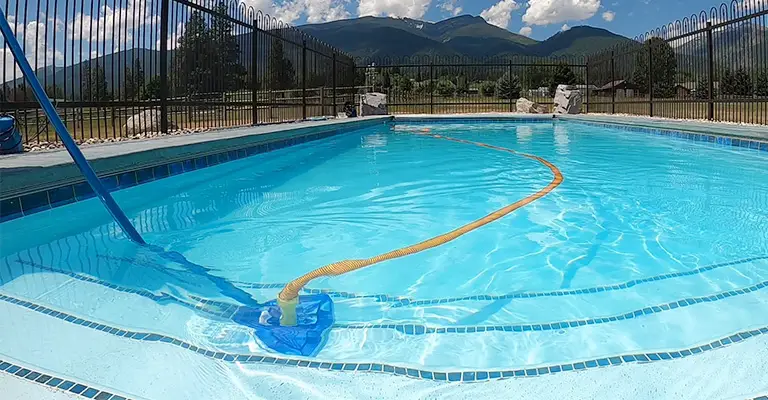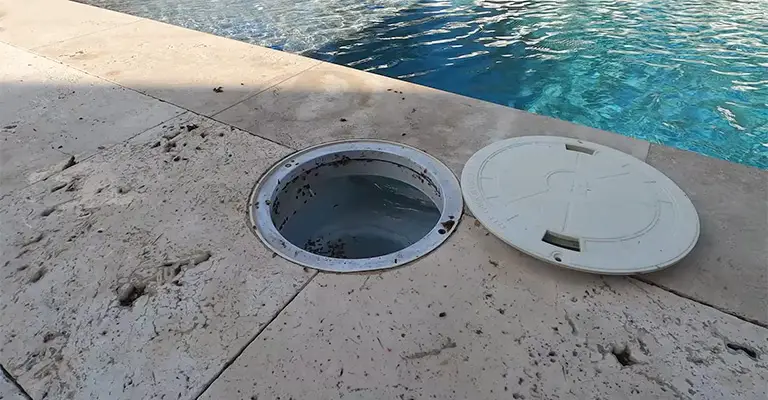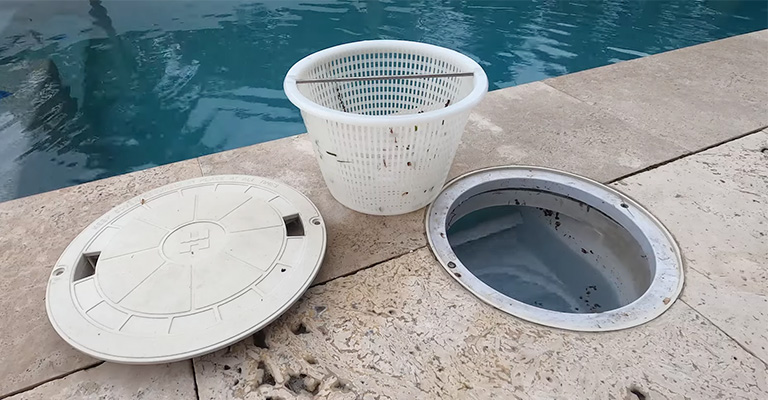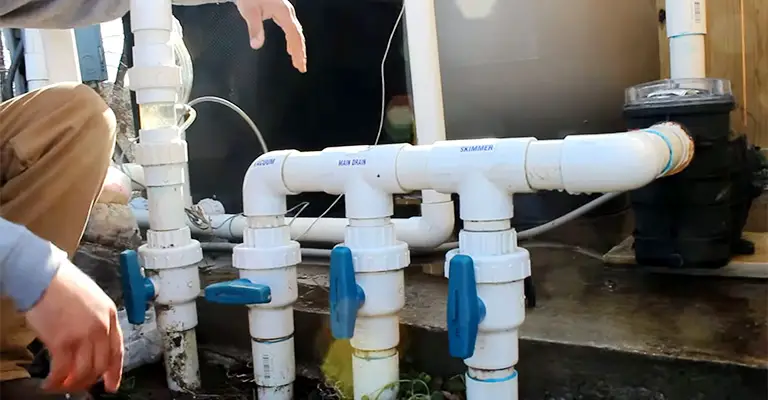The key to having the perfect backyard pool is maintaining it properly. For your pool to stay clean and your water to be crystal clear, you need to know how to adjust pool skimmer suction.
Floaters of leaves and other debris and cloudy water aren’t something anyone wants to see in their pools. Maintaining a pool properly can provide a relaxing oasis in your own backyard, but that doesn’t happen by accident.
Although maintaining a pool may seem difficult, it’s actually quite easy if you understand the basics.
A properly adjusted skimmer suction can keep your pool clean, but when adjusted incorrectly, debris can be left on the surface, or the circulation of water is poor.
You don’t need to be an expert to master the art of skimmer suction. You can keep your pool clean and inviting for many years if you have the right knowledge and tools.
How Do You Know if Your Skimmer’s Suction is Low?
Check your filter tank’s pressure gauge. The base or starting pressure of your filter will depend on the flow rate of your tank (please refer to your tank’s manufacturer’s instructions if you do not know it).
To reset the PSI, after backwashing the filter and pump basket, the PSI should be within a normal range. Let the pump run as usual after restarting it.
You will likely have a low suction issue if either the PSI rises 5-10 pounds on the gauge, or it reads lower than average.
PSI should range from 10 to 25 depending on your filter model. Anything above or below this range is abnormal.
You may have an obstruction after the pump if your pressure is higher than average. Generally, if it is lower than average, your obstruction is on the suction side of the system – before the pump.
The following are other signs of a problem:
- Sounds of bubbling
- A loud pump
- Water jets are making a slow return
- A dirty, insect-infested pool
Everything You Need To Know About How To Adjust Pool Skimmer Suction

Cleaning a pool regularly is only part of keeping it sparkling; the suction in the pool skimmer must also be adjusted.
Maintaining your pool filters ensures your pool water looks crystal clear and your filters operate optimally. How do you adjust the suction on your own pool skimmer? Let’s find out!
In order to maintain a healthy swimming pool, adjusting the skimmer suction properly is one of the most important things to do.
A correctly adjusted skimmer suction helps maintain a free flow of water and ensures that the pool filters are functioning properly.
Understanding a pool skimmer’s components and understanding the basics will help you adjust the suction.
An in-pool skimmer works by collecting debris and maintaining a constant flow of fresh water through pipes, valves, and hoses.
Skimmer valves regulate the amount of suction in the system by regulating how much water is pumped through them.
You can adjust this valve to ensure that the pool filters always run at the correct speed and regulate the amount of suction.
Check the skimmer valve first before adjusting the suction. The suction system pressure should be checked, and the valve should be in the correct position.
Verify that the valve is in the correct position, and then adjust the pressure accordingly. Ensure that any damaged or broken parts are replaced as soon as possible.
To ensure that your pool skimmer is working properly, you should routinely inspect it after adjusting the skimmer valve.
The pool filter should also be backwashed periodically, and the skimmer should be checked for blockages or debris. Maintaining your pool skimmer and pool filters regularly will help them function at their best.
Also, maintaining your pool skimmer suction can help you maintain a desired level of pressure while keeping debris out of your pool.
Air Leaks
There is nothing worse than an air leak in your skimmer. You can imagine how difficult it would be to drink from a straw with a hole in it.
Leaks occur frequently when there is a faulty valve, a loose drain plug, low water levels, a blockage or a clogged impeller.
Solution
Several factors can cause an air leak, but the most common and easiest one to fix is a loose pump lid. Try opening the lid and reattaching it very firmly if it appears to be cracked. Make sure it forms a tight seal by giving it a few more turns.
If this doesn’t work, try servicing your o-rings. Clean, lubricate, and replace the o-rings properly in all caskets, valves, and lids containing o-rings. Once again, run the skimmer.
Jammed Skimmer Suction Line

A skimmer has two main lines: a return line and a suction line. The suction lines would be the most likely place for a blockage, since return lines deliver clean water only. This issue may be indicated by an unusually loud pump with low suction.
Solution
Closure of the other intake lines should be followed once you have identified the problematic suction line.
There should only be one open line, the clogged one. Your garden hose can be placed within the pump’s lid to force water down the line, dislodging the blockage with its force.
As a result, the pipe should be freed up. Nevertheless, if the blockage persists, you may want to consult a professional.
Clogged Impeller
Pool pumps depend on their impellers. Water is pushed and pulled out for cleaning by it. Your pool’s suction may be low if something has blocked it.
Solution
Your impeller needs to be cleaned. You may want to inspect the pool basket if you continue to experience this issue – it might be broken, resulting in debris repeatedly blocking the impeller.
Your regular maintenance check should include the impeller, since it maintains suction.
Skimmer Basket Blockage

Make sure that there are no blockages in your skimmer basket. Surface water overflows into a suction pipe that goes to a filter through the skimmer basket.
Lower water pressure could result if the pipe between the pump and skimmer is blocked.
Solution
Make sure all material collected in the basket is removed (use a pair of gloves, it can get quite dirty).
Following the removal of all blockages, spray the area with water. This should be done on a regular basis. To prevent future buildup, you can use a pool skimmer sock.
Stained Cartridge Filters
You need to ensure that all other parts of your pool’s equipment are working together in order for it to be clean.
Ensure that your pool’s filtration system is running smoothly, and especially that the cartridge filters are clean, unblocked, and in good working condition.
The cause of low suction in your pool may be worn or frayed bands, flattened pleats, cracked end caps, or excessive oiliness on your filter.
Solution
Let the cartridge filters soak overnight in a cleaning solution to remove grease, and make sure they are effectively filtering water.
It is recommended to replace them entirely if they remain brown despite this. You might have to replace the sand if you use a sand filter. Sand should be replaced as well.
Low Water Levels
Your skimmer may have difficulty pulling in water to clean your pool if the water level is low. In low water levels, bubbles can occur, overheating can occur, or air can be sucked into the filter system, potentially overstraining it.
Solution
It’s quite simple to fix. Make sure you open the valve that lets water into your pool and that it reaches the appropriate level for the size of your pool and your skimmer.
To maintain a steady level of water pressure, the water level must be approximately half the opening of the skimmer.
Why Is Skimmer Suction Important?
Maintaining a clean and healthy swimming pool requires knowledge of how to adjust the suction of your pool skimmer.
Skimmer suction must be set correctly in order to ensure that the filtration system is as effective as possible and to reduce unnecessary wear and tear.
In addition, improper skimmer suction could also lead to excessive buildup of pool debris, algae growth, and cloudiness.
As a result of the pool skimmer’s suction, water and foreign matter are drawn away from the pool surface and into filtration systems.
The debris is prevented from settling at the pool’s surface, where it would otherwise adhere to the walls and become much more difficult to remove.
Depending on how low the suction is set, light and small debris such as leaves and dirt may not be able to be pulled away.
A high setting, however, can create excessive stress on the pool’s pump and filter as well as turbulence in the pool, making it difficult to swim.
For your pool to be clean and sanitary, you must find the sweet spot for skimmer suction. The correct adjustment of skimmer suction will ensure your pool stays in top condition for years to come.
Getting the Skimmer Suction Corrected: Understanding the Skimmer Suction Adjustment Process
Skimmer suction should be adjusted regularly to keep the pool clean and free of debris as part of pool maintenance.
Using the skimmer, larger debris can be removed from the pool’s surface. A filter’s suction system distributes the water evenly to the skimmer and filter throughout the entire pool.
An incorrectly adjusted suction can cause the pool to become dirty and unbalanced, resulting in a harder time maintaining it.
A pool skimmer’s suction can be troubleshooted by first checking the skimmer.
Check that the skimmer is installed correctly and that all connections are secure before using it. You will need to repair any leaks or cracks before adjusting the suction.
The next step is to adjust the suction once the skimmer is in good condition. Alternatively, you can use a skimmer diverter valve to manually adjust the valve.
In order to prevent problems, make sure the valve setting is correct for your pool, so it is important not to adjust it too high or too low.
Be sure that no obstructions are blocking the skimmer, as this can affect its suction.
The pool should be regularly inspected after the suction has been adjusted for any signs of wear and tear.
Furthermore, ensure the filter is not clogged or blocked, since this can prevent the skimmer from maintaining clean water.
The proper suction of your pool can be maintained by keeping it clean and performing regular maintenance.
The beauty and health of your pool can be maintained all summer long with a little care and attention.
Health and safety are important considerations when maintaining a swimming pool. It doesn’t matter what your pool repair needs are, there is always someone you can turn to.
Making Sure Your Pool’s Suction Levels Are At Their Best: How To Assess Them
Getting your pool ready for swimming and relaxation can take quite a bit of time and effort, but understanding how to adjust the suction on your pool skimmer can make a big difference.
The following points will help you determine your pool’s suction levels and make any necessary changes.
Understanding the pool’s suction components is the first step. The suction in the pool skimmer is responsible for pulling water into the skimmer, which then filters the water.
The suction in the pool may not be strong enough to remove adequate amounts of debris if the suction is set too low.
A water level that is too high could overwhelm the skimmer and prevent it from cleaning effectively. Keeping a pool healthy requires finding the right suction setting.
To determine the suction setting, the second step is to measure it. Alternatively, you can place a small Tupperware dish in front of the skimmer on the surface of the pool.
Floating bowls should be drawn toward skimmer inlets (referred to as “skim-sucking”), but suction should not cause the bowl to sink.
It is likely that the bowl is stuck to the skimmer due to too much suction. Having a low suction setting will not pull the bowl in at all.
The next step is to verify that the pool’s plumbing doesn’t have any leaks after you’ve found the optimal suction setting and adjusted the valve.
By checking the pool’s water level or looking for any wet spots, you can determine whether it needs to be cleaned.
You should also regularly backwash the pool filter to ensure that it is running efficiently and effectively.
The last thing you should do to keep your pool’s water clean is to regularly inspect the skimmer basket.
Final Words
It is not easy to maintain a pool, but knowing how to adjust the suction on the pool skimmer does make the job a little easier.
By adjusting the suction on your pool’s skimmer, you can keep your pool clean and free of debris, bacteria, and germs.
Adjusting a pool’s skimmer suction requires knowledge of how the suction valve, water level, and suction gauge are adjusted.
If you adjust the skimmer suction with patience and practice, you’ll be a pro in no time.
You can easily adjust the suction of your pool skimmer at home if you have the right information and guidance.








